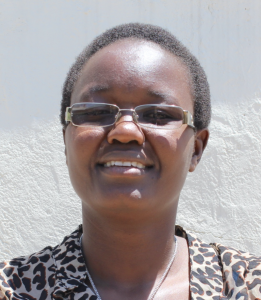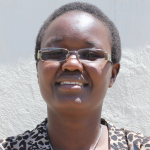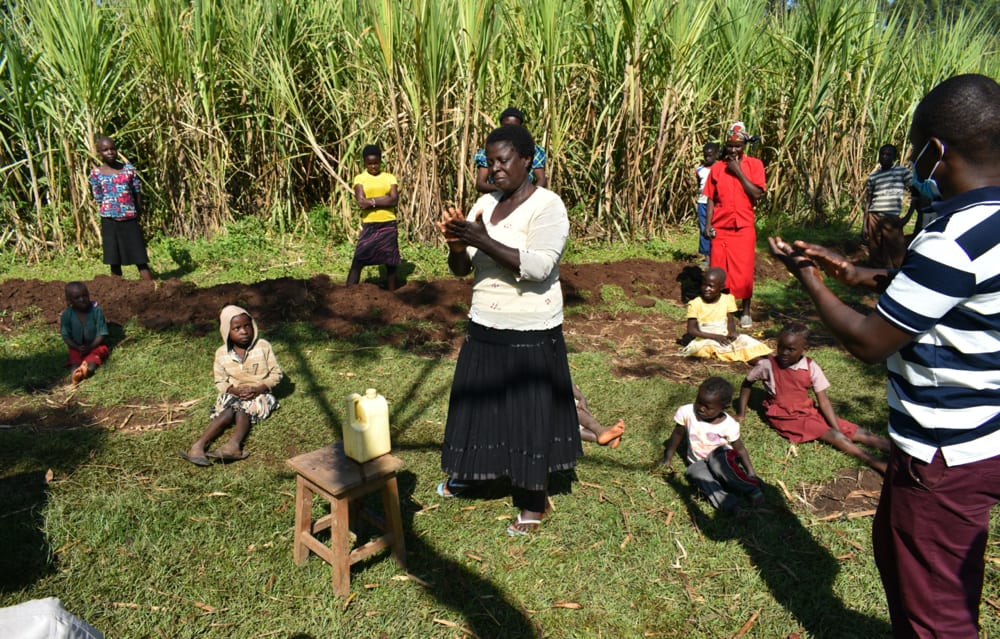Yakobo Spring is the only source of water for 150 people in Indulusia, where the community depends on farming as their livelihood. The area is well vegetated with sugarcane, maize, bananas, sweet potatoes, and vegetables. The topography is hilly and sloping, making the area unique.
Community members here must fetch water every morning, noontime, and evening. If they cannot get clean water during these hours due to long lines or because the water is extra dirty from others fetching it, they are forced to return some other time. All of this time lost at the spring disrupts their other daily activities because they have to priortize getting water for drinking, cooking, and bathing.
Sometimes at the spring, women will fight a lot because each of them needs to fetch water quickly, but the space is small and this leads to conflict. The large crowds and long lines at the spring are especially concerning during the pandemic, when community members are trying to avoid groups and limit their time spent in public.
Because the spring is open, the immediate area is very muddy and a small stream forms from the spring's runoff. Consequently, mothers are too scared to send their youngest children to fetch water for fear they will fall inside the water or get stuck in the mud and drown. That puts even more burden on the women and the older children to fetch water, who miss out on productive work time and school and homework time, respectively.
"It's very difficult for us children to access the spring, especially during rainy season. The unprotected spring surroundings become so muddy and slippery, making it difficult to carry water and resulting in some of us breaking the containers because of falling while carrying water from the spring," reported young primary student Alfred.
The water source has a lot of water with high discharge but the spring is open and therefore prone to contamination. Toxins in the water range from dirty surface runoff that carries farm chemicals and animal waste, to mud, bacteria, parasites, and algae. When it rains, the amount of mud in the water increases, forcing community members to try to clean out what they can around the spring area. They then have to wait even longer between users to fetch it, but they can't afford the time needed to truly let the water settle.
To aid water collection at the spring, the community improvised a plastic discharge pipe that they inserted directly into the earth. Because of its lightweight nature, the pipe is often washed away by the spring's high yield, and at the worst times, cracked or damaged. It is difficult to continue paying for replacements, so sometimes they have to make do without it.
Community members report regular water-related illnesses after consuming the spring water.
"Because the spring is unprotected, we have really suffered from cough and typhoid for a long time. We are tired of drinking water from an open place because anybody can do anything evil to contaminate the water, but now that Yakobo spring will be protected soon, we will be able to access clean and safe water for drinking," said a hopeful Jane Isaiah, a 38-year-old farmer and mother in Indulusia.
The adults told us of their children who were coughing a lot, forcing them to visit the hospital frequently. They said they are praying that after the spring protection, they will no longer visit the hospital and they will be able to use the money that once went to hospital bills and medication for other essential needs.
What We Can Do:
Spring Protection
Protecting the spring will help provide access to cleaner and safer water and reduce the time people have to spend to fetch it. Construction will keep surface runoff and other contaminants out of the water. With the community’s high involvement in the process, there should be a good sense of responsibility and ownership for the new clean water source.
Fetching water is a task predominantly carried out by women and young girls. Protecting the spring and offering training and support will, therefore, help empower the female members of the community by freeing up more of their time and energy to engage and invest in income-generating activities and their education.
Training on Health, Hygiene, COVID-19, and More
To hold trainings during the pandemic, we work closely with both community leaders and the local government to approve small groups to attend training. We ask community leaders to invite a select yet representative group of people to attend training who will then act as ambassadors to the rest of the community to share what they learn. We also communicate our expectations of physical distancing and wearing masks for all who choose to attend.
The training will focus on improved hygiene, health, and sanitation habits in this community. We will also have a dedicated session on COVID-19 symptoms, transmission routes, and prevention best practices.
With the community’s input, we will identify key leverage points where they can alter their practices at the personal, household, and community levels to affect change. This training will help to ensure participants have the knowledge they need about healthy practices and their importance to make the most of their water point as soon as water is flowing.
Our team of facilitators will use a variety of methods to train community members. Some of these methods include participatory hygiene and sanitation transformation, asset-based community development, group discussions, handouts, and demonstrations at the spring.
One of the most important issues we plan to cover is the handling, storage, and treatment of water. Having a clean water source will be extremely helpful, but it is useless if water gets contaminated by the time it is consumed. We and the community strongly believe that all of these components will work together to improve living standards here, which will help to unlock the potential for these community members to live better, healthier lives.
We will then conduct a small series of follow-up trainings before transitioning to our regularly scheduled support visits throughout the year.
Training will result in the formation of a water user committee, elected by their peers, that will oversee the operations and maintenance of the spring. The committee will enforce proper behavior around the spring and delegate tasks that will help preserve the site, such as building a fence and digging proper drainage channels. The fence will keep out destructive animals and unwanted waste, and the drainage will keep the area’s mosquito population at a minimum.
Sanitation Platforms
At the end of the training, participants will select 5 families that should benefit from new concrete latrine floors called sanitation platforms. Training will inform the community and selected families on what they need to contribute to make this project a success. They must mobilize locally available materials, including bricks, clean sand, and gravel.
The 5 families chosen for sanitation platforms must prepare by sinking a pit for the sanitation platforms to be placed over. Our trainers then instruct them on how to build superstructures over their new platforms. These 5 sanitation platforms will serve as examples for the rest of the community to replicate.
All community members must work together to make sure that they continuously provide accommodations and food for the work teams throughout all stages of spring and sanitation platform construction.

 Protected Spring
Protected Spring
 Rehabilitation Project
Rehabilitation Project






















































